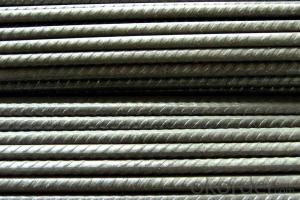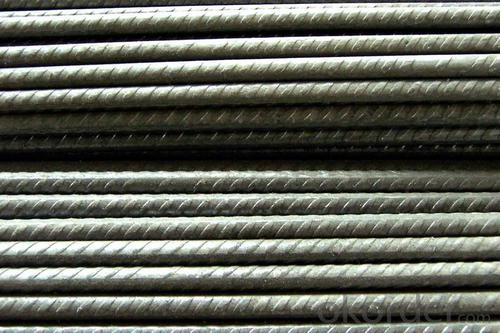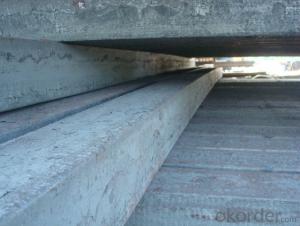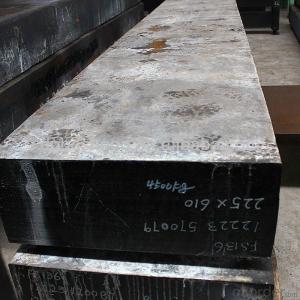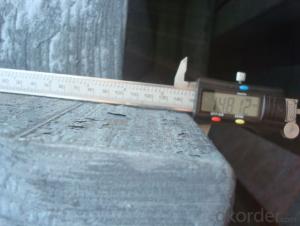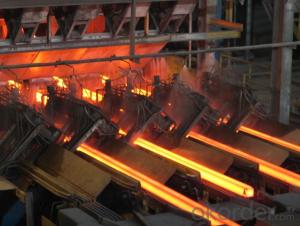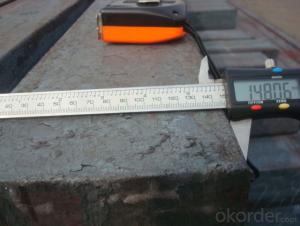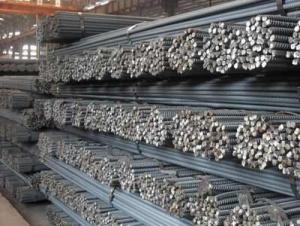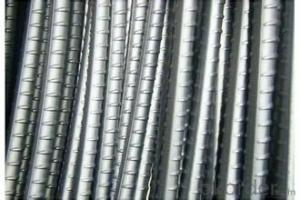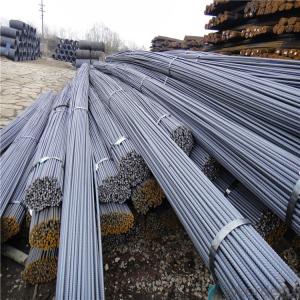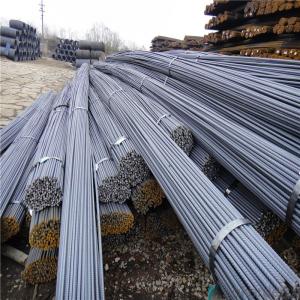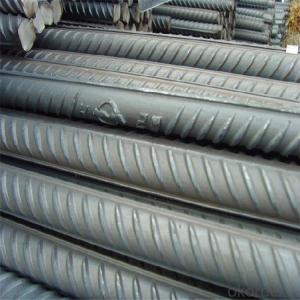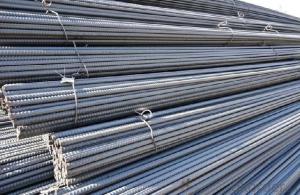Deformed Steel Bar 8_25
- Loading Port:
- China Main Port
- Payment Terms:
- TT OR LC
- Min Order Qty:
- -
- Supply Capability:
- -
OKorder Service Pledge
OKorder Financial Service
You Might Also Like
Theoretical weight and section area of each diameter as below for your information:
Diameter(mm) | Section area (mm²) | Mass(kg/m) | Weight of 12m bar(kg) |
6 | 28.27 | 0.222 | 2.664 |
8 | 50.27 | 0.395 | 4.74 |
10 | 78.54 | 0.617 | 7.404 |
12 | 113.1 | 0.888 | 10.656 |
14 | 153.9 | 1.21 | 14.52 |
16 | 201.1 | 1.58 | 18.96 |
18 | 254.5 | 2.00 | 24 |
20 | 314.2 | 2.47 | 29.64 |
22 | 380.1 | 2.98 | 35.76 |
25 | 490.9 | 3.85 | 46.2 |
28 | 615.8 | 4.83 | 57.96 |
32 | 804.2 | 6.31 | 75.72 |
36 | 1018 | 7.99 | 98.88 |
40 | 1257 | 9.87 | 118.44 |
50 | 1964 | 15.42 | 185.04 |
Usage and Applications of Construction
1. Construction steel round bar is mostly used for straight bundles supply, and used for steel, bolts and various mechanical parts. While the bigger round bar, or more than 25mm hot rolled bar, is mainly for the manufacture of mechanical parts or for seamless steel billet.
2. Steel round bar is used in construction and a large number of architectural and engineering structures.
3. Besides, we can supply some especial material steel round bar that can be used for main shaft of steamer, hummer shank, with big section and supper force.
Packaging & Delivery
Packaging Detail: All goods are packed in bundle with steel strips and shipped by break bulk vessel or container (depend on target market and different ports)
Delivery Detail: 45 days
Trade terms: FOB, CFR, CIF
MOQ: 25 tons per specification; we can negotiate the quantity if the specification is normal or we have stock of one specification.
Weight: Theprice invoicing on theoretical weight basis or actual weight basis depends on customer’s request.
Shipment: The shipment of bulk break or container is depends on customer’s request and the situation of the port of destination.
Documents given: Full set of original clean on board bill of lading; Original signed commercial invoice; Original packing list; Policy of insurance; Certificate of origin and what the target market needs.
- Q: What are the different types of steel billet packaging materials?
- When selecting the suitable packaging material for steel billets, it is crucial to take into account the unique characteristics and benefits of the various options available in the market. The following are some commonly utilized packaging materials for steel billets: 1. Wooden Crates: Renowned for their durability and strength, wooden crates are a favored choice for packaging steel billets. They offer exceptional protection against external impacts and are particularly suitable for long-distance transportation. 2. Steel Strapping: Frequently employed to bundle steel billets together, steel strapping is a robust and secure packaging material. It boasts high tensile strength and resistance to breakage, ensuring that the billets remain intact during handling and transportation. 3. Plastic Wrapping: As a cost-effective and lightweight packaging option, plastic wrapping provides ample protection against moisture and dust, preventing any potential damage to the billets. Moreover, it is easily applicable and removable, rendering it a convenient choice for packaging. 4. Steel Framing: For larger and heavier steel billets, steel framing serves as a heavy-duty packaging material. It offers maximum protection and stability during transportation, effectively minimizing the risk of deformation or damage to the billets. 5. Cardboard Boxes: Smaller steel billets frequently find themselves packaged in cardboard boxes. These boxes are lightweight, easy to handle, and offer sufficient protection against minor impacts and scratches. Additionally, cardboard boxes can be customized in various sizes and shapes to accommodate different billet dimensions. 6. Stretch Film: Stretch film, a flexible packaging material, is commonly employed to wrap steel billets. It provides exceptional protection against moisture, dust, and scratches. Furthermore, stretch film imparts a certain level of stability to the billets, preventing any movement during transportation. When selecting the appropriate packaging material, it is crucial to consider the specific requirements of the steel billets, including size, weight, and transportation conditions.
- Q: Can steel billets be customized in terms of shape and size?
- Steel billets have the capability to be personalized when it comes to their shape and size. These semi-finished products are typically rectangular in form and are utilized as raw materials for various manufacturing procedures. Nonetheless, they can be modified to fulfill specific requirements through a technique known as billet rolling or cross-rolling. Throughout this procedure, the steel billets are subjected to a series of rolls that are specially designed to exert pressure and force, resulting in their reshaping. This permits the customization of the billets into various shapes and sizes, such as square, round, or hexagonal, depending on the desired final product. Furthermore, the size of the steel billets can also be tailored. The initial dimensions of the billets can be altered by either increasing or decreasing their length, width, and height. This adaptability in customization empowers manufacturers to fabricate steel billets that best suit their specific production requirements. To sum up, steel billets can undoubtedly be customized in terms of both shape and size through the process of billet rolling. This empowers manufacturers to adjust the billets according to their desired specifications, enabling the creation of a wide array of products utilizing steel as a primary material.
- Q: How are steel billets stored?
- Steel billets are typically stored in a controlled environment to protect them from corrosion and other damages. The storage method varies depending on the size and quantity of the billets, as well as the specific needs of the steel manufacturer. One common method of storing steel billets is to stack them horizontally on a flat surface. This can be done on a concrete floor or on steel racks designed for this purpose. The billets are usually placed in rows and columns, with enough space between them to allow for easy access and inspection. In order to prevent corrosion, the billets are often coated with a protective layer, such as oil or rust inhibitors, before being stored. Additionally, the storage area may be equipped with dehumidifiers or climate control systems to maintain ideal humidity levels and prevent moisture from damaging the steel. For larger quantities of billets, they may be stored vertically in specialized racks or bins. This allows for better space utilization and easier handling with the help of machinery like cranes and forklifts. These vertical storage systems are designed to ensure that the weight of the billets is evenly distributed to prevent any deformation or damage. Regardless of the storage method used, it is crucial to regularly inspect the billets for any signs of damage or deterioration. This includes checking for rust, cracks, or any other defects that may affect the quality of the steel. Proper documentation and inventory management are also important to ensure efficient retrieval and usage of the billets. Overall, steel billets are stored in a manner that prioritizes their protection and preservation. By following appropriate storage practices, steel manufacturers can maintain the quality of the billets and ensure their suitability for subsequent manufacturing processes.
- Q: How are steel billets used in the manufacturing of railway tracks?
- Steel billets are indispensable in the production of railway tracks, serving as the primary material from which the tracks are made. To initiate the process, the steel billets are subjected to high temperatures, typically reaching around 1200 degrees Celsius, in a furnace. This heating procedure effectively softens the steel, rendering it more pliable. Once heated, the billets are then passed through a series of rollers in a process known as hot rolling. This entails continuously guiding the billets through the rollers to gradually reduce their thickness and shape them into elongated, slender strips. The hot rolling technique also serves to refine the inner structure of the steel, enhancing its strength and durability. Following the hot rolling process, the steel strips are subsequently divided into smaller segments, referred to as rails. Thorough inspection is conducted to identify and address any defects or imperfections prior to further processing. These rails then undergo a finishing process, wherein any surface irregularities or imperfections are eliminated through grinding or polishing. To enhance their strength and resistance to wear and tear, the finished rails are subjected to various techniques. This may involve heat treatment methods such as quenching and tempering, which further enhance the rails' hardness and toughness. Additionally, protective coatings may be applied to the rails to prevent corrosion and extend their lifespan. Ultimately, the rails are transported to the construction site where they are laid and securely fastened to the sleepers or ties, forming the railway track. The steel rails provide a robust and dependable foundation for train travel, capable of enduring heavy loads and constant usage due to their strength and durability. In conclusion, steel billets play a crucial role in the production of railway tracks, undergoing multiple processes to transform into resilient rails that offer a solid foundation for trains to operate on. The use of steel billets guarantees that the railway tracks are strong, long-lasting, and capable of withstanding the demands of heavy train traffic.
- Q: Are steel billets magnetic?
- Indeed, steel billets possess magnetic qualities. As an alloy predominantly consisting of iron, steel constitutes a ferromagnetic substance, rendering it capable of magnetization. Consequently, steel exhibits magnetic properties. Given that steel billets are solid blocks or bars composed of steel, they retain the magnetic characteristics inherent to their constituent material.
- Q: What are the main characteristics of high-quality steel billets?
- The main characteristics of high-quality steel billets include superior chemical composition, uniform and refined microstructure, precise dimensions, and excellent surface quality. Firstly, high-quality steel billets have a superior chemical composition. This means that they are made from carefully selected raw materials and have the right balance of elements to ensure optimal strength, durability, and corrosion resistance. The chemical composition is crucial in determining the overall quality and performance of the steel billets. Secondly, high-quality steel billets have a uniform and refined microstructure. This means that the grains within the steel are evenly distributed and have been properly refined during the manufacturing process. A uniform and refined microstructure enhances the strength and toughness of the steel, making it more resistant to cracking, deformation, and other forms of mechanical stress. In addition, high-quality steel billets have precise dimensions. They are manufactured to strict tolerances, ensuring that they have the correct length, width, and thickness. Precise dimensions are important as they allow for easy and accurate machining, forging, or rolling of the billets into the desired end products. This ensures that the final products made from the billets have consistent and accurate dimensions. Lastly, high-quality steel billets have excellent surface quality. They are free from defects such as cracks, scale, or other surface imperfections. A smooth and clean surface allows for better heat transfer, improved weldability, and enhanced overall appearance of the final products. It also ensures that the billets can be easily inspected and processed without any hindrances. Overall, high-quality steel billets possess superior chemical composition, uniform and refined microstructure, precise dimensions, and excellent surface quality. These characteristics are essential in producing steel billets that meet the highest standards of strength, durability, and reliability, making them suitable for various industrial applications.
- Q: How are steel billets reheated before rolling or forging?
- Steel billets are reheated before rolling or forging through a process known as billet heating. This process involves subjecting the billets to high temperatures to make them more malleable and easier to shape. There are several methods commonly used for billet heating, including: 1. Furnaces: The most common method of reheating steel billets is through the use of furnaces. These furnaces are typically gas-fired and can reach temperatures of up to 1,200 degrees Celsius. The billets are loaded into the furnace and heated for a specific period of time to achieve the desired temperature. The furnace provides a controlled environment, allowing for even heating and uniformity. 2. Induction heating: Another method used for reheating steel billets is induction heating. This process utilizes electromagnetic induction to heat the billets. An alternating current is passed through a copper coil, creating a magnetic field. The billets are then placed inside the coil, and the magnetic field induces eddy currents within the billets, generating heat. Induction heating offers precise temperature control and rapid heating rates, making it suitable for high-speed production. 3. Electric resistance heating: Electric resistance heating is another technique employed for reheating steel billets. This method involves passing an electric current through the billets, causing them to heat up due to the resistance encountered. Electric resistance heating can be achieved using various types of heating elements, such as graphite electrodes or resistance heating wires. This method offers precise temperature control and is commonly used for smaller-scale operations. Regardless of the heating method used, it is essential to carefully control the temperature and heating time to ensure the billets reach the optimal temperature for rolling or forging. The reheating process allows the steel to become more pliable, reducing its hardness and increasing its ductility, making it easier to shape and form into the desired end product.
- Q: I want to buy a fishing pole, I don't know how to distinguish it. Know what, please reply, thank you, [em10]!
- When it comes to the differentiation of carbon fishing rods, first of all, what are the different kinds of fishing rods containing carbon?!Carbon rod is now sold in the market are divided into three kinds, namely: carbon, pure carbon, high carbon. These three categories.1, carbon packaging, as its name implies, two layers of material, the outside layer is carbon cloth, the inside layer is glass fiber, epoxy cloth. The price of this kind of rod is lower, because it is not necessary to buy a brand because of the lower price. With a few times you can change, for beginners.2, pure carbon refers to the overall use of 30T below carbon cloth fishing rod, general 24T, 30T based, carbon content of more than 98%. Moderate price.3, high carbon refers to the overall use of more than 30T carbon cloth fishing rod, but not the whole fishing rod is made of a carbon cloth. The tonality of a fishing rod is actually modulated by a different modulus of carbon cloth.Some fishing overall with the 30T following carbon cloth, just use a very small amount of 40T or 46T carbon cloth, called high carbon rod, is actually confuse the public practice of fishing by weighing, hand identification, high carbon rod with real light, hard, two rods in a play, a ratio is obvious.
- Q: How do steel billets contribute to the defense industry?
- Steel billets contribute to the defense industry by serving as a primary material for manufacturing various defense equipment and vehicles. These billets are used to produce armored vehicles, tanks, naval vessels, aircraft carriers, submarines, and military-grade weapons. The high strength and durability of steel make it ideal for creating protective structures and components that can withstand extreme conditions, ballistic impacts, and explosive forces. Additionally, steel billets are also utilized in the construction of defense infrastructure, such as military bases and facilities.
- Q: How do steel billets contribute to the overall energy efficiency of a structure?
- There are several ways in which steel billets enhance the energy efficiency of a structure. To begin with, steel is an incredibly durable material that can withstand the test of time. Consequently, structures constructed using steel billets have a longer lifespan, which reduces the frequency of maintenance and repairs. As a result, energy consumption and costs decrease over time. Furthermore, steel boasts excellent heat and electricity conductivity. This characteristic facilitates the efficient distribution of thermal energy throughout the structure, thereby reducing the need for additional heating or cooling systems. Steel structures are proficient at regulating internal temperature and minimizing energy loss, resulting in improved energy efficiency. Moreover, steel manufacturing processes have become increasingly energy-efficient in recent years. Modern techniques involve recycling scrap steel, utilizing electric arc furnaces, and implementing advanced technologies to minimize energy consumption during the production of steel billets. This emphasis on energy efficiency during the manufacturing stage translates into reduced environmental impact and energy savings throughout the lifespan of the structure. Additionally, steel structures can be designed to optimize natural lighting and ventilation. This reduces reliance on artificial lighting and mechanical ventilation systems. Incorporating features like large windows, skylights, and well-designed air circulation systems enables steel structures to minimize the need for energy-consuming lighting fixtures and HVAC systems, further enhancing energy efficiency. In conclusion, steel billets contribute to the overall energy efficiency of a structure through their durability, thermal conductivity, and energy-efficient manufacturing processes. By opting for steel as a building material, structures can benefit from reduced maintenance requirements, efficient temperature regulation, and minimized energy consumption. This leads to long-term energy savings and a more sustainable built environment.
Send your message to us
Deformed Steel Bar 8_25
- Loading Port:
- China Main Port
- Payment Terms:
- TT OR LC
- Min Order Qty:
- -
- Supply Capability:
- -
OKorder Service Pledge
OKorder Financial Service
Similar products
Hot products
Hot Searches
Related keywords
